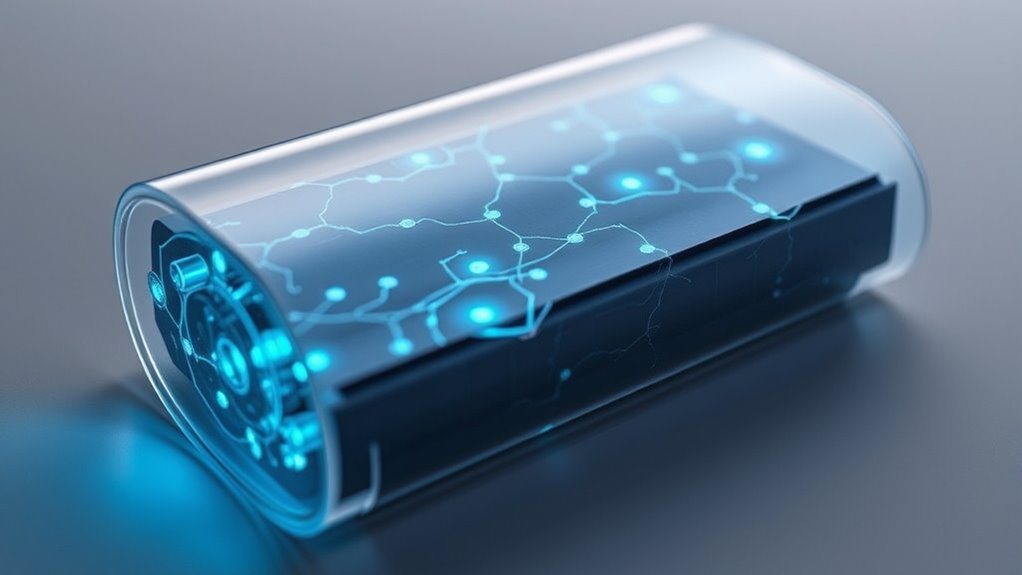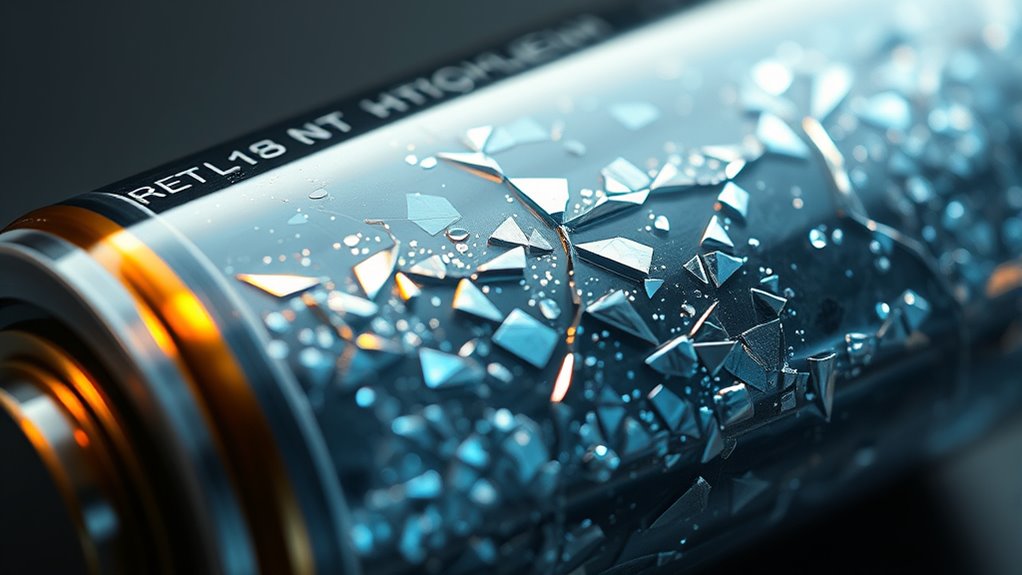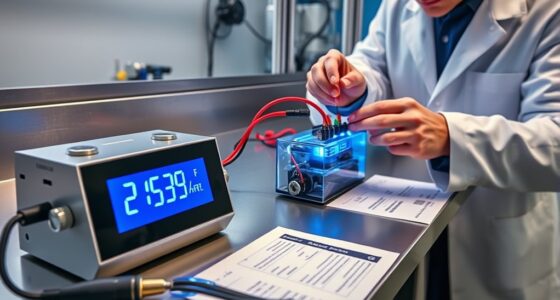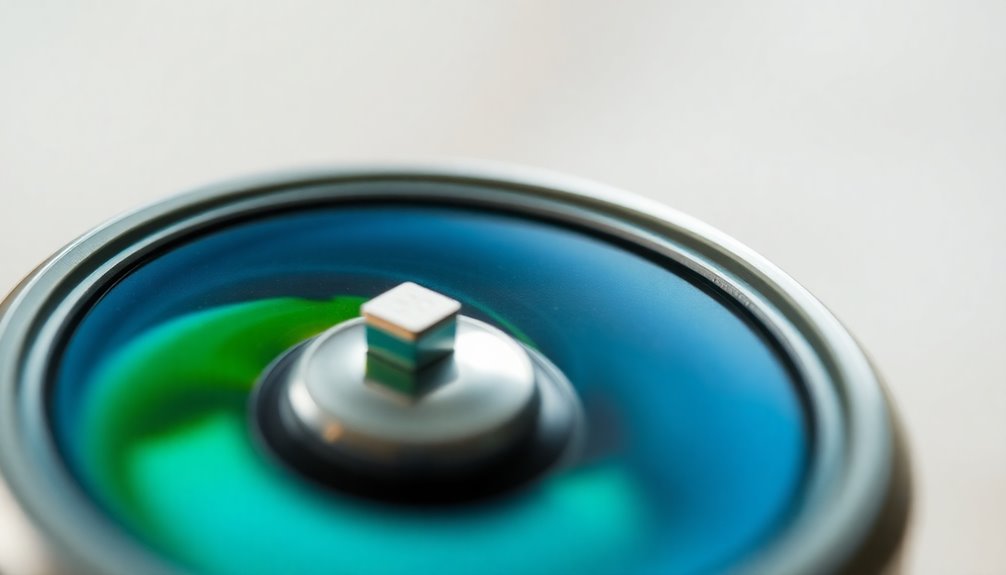Self-healing batteries work by using special materials in the electrolyte and electrodes that can repair themselves after damage. When cracks or other issues occur, these materials respond by forming new bonds or releasing healing agents to seal gaps, restoring electrical connection and preventing failures. This makes the battery more durable, safe, and long-lasting. If you keep exploring, you’ll discover how innovative materials are transforming energy storage for various applications.
Key Takeaways
- Self-healing batteries utilize specially designed electrolytes that respond to damage by forming bonds and sealing cracks.
- They incorporate materials like elastic polymers or microcapsules with healing agents to automatically repair physical damage.
- Damage triggers chemical reactions within the electrolyte, restoring electrical continuity and maintaining performance.
- Self-healing materials absorb shocks and resist cracking, preventing failures like short circuits and enhancing safety.
- This technology extends battery lifespan, reduces replacements, and enables more durable, reliable energy storage solutions.

Self-healing batteries are an innovative breakthrough that promises to enhance the durability and longevity of energy storage devices. As a user, you’ll benefit from batteries that can repair themselves after damage, reducing replacements and maintenance costs. One of the key factors behind this technology is electrolyte optimization. By carefully designing the electrolyte, researchers can create a medium that not only conducts ions efficiently but also participates actively in the self-healing process. These advanced electrolytes often contain materials that respond to cracks or damages by forming new bonds, sealing gaps and restoring electrical continuity. This means your battery can recover from minor punctures or fractures without losing performance. Electrolyte optimization guarantees that the self-healing process is both fast and reliable, maintaining the battery’s capacity over many charge cycles. Additionally, incorporating self-healing materials into the battery structure enhances its ability to recover from mechanical damage, further extending its lifespan.
Mechanical durability plays a vital role in making self-healing batteries practical. Traditional batteries tend to degrade mechanically over time due to repeated expansion, contraction, and physical stress during charge and discharge cycles. With self-healing materials, you gain a significant advantage: the ability to withstand and recover from mechanical damage. These materials are designed to absorb shocks, resist cracking, and automatically repair themselves when damaged. For example, incorporating polymers with elastic properties or microcapsules filled with healing agents can help the battery’s structure rebound after stress. This resilience boosts the overall mechanical durability, meaning your battery remains functional even under harsh conditions or prolonged use. The combination of flexible, self-healing materials and optimized electrolytes results in a more robust energy storage system that can endure real-world challenges.
Moreover, the integration of self-healing capabilities doesn’t just improve lifespan but also enhances safety. Damage in conventional batteries can lead to short circuits or thermal runaway, but self-healing materials can prevent such failures by sealing cracks before they cause serious issues. As you use these batteries, you’ll notice fewer performance drops over time, fewer replacements, and less concern about damage during handling or extreme conditions. The ongoing research in electrolyte optimization and mechanical durability aims to make these batteries more efficient, cost-effective, and adaptable for a wide range of applications—from portable electronics to electric vehicles and grid storage. Ultimately, by combining smart material design with innovative chemistry, self-healing batteries are set to revolutionize energy storage, giving you longer-lasting, safer, and more reliable power sources.
Frequently Asked Questions
How Long Do Self-Healing Batteries Typically Last?
Self-healing batteries usually last between 5 to 10 years, depending on usage and environmental factors. You might find that their battery lifespan extends because repairs happen automatically, reducing the need for frequent replacements. However, repair frequency can influence longevity; if the self-healing process is efficient, your battery can maintain performance longer. Keep in mind, regular usage and proper care can further enhance the battery’s lifespan.
Are Self-Healing Batteries More Cost-Effective Than Traditional Ones?
You’ll find self-healing batteries can be more cost-effective over time, especially when considering their longer lifespan and reduced maintenance needs. A recent cost analysis shows they could save up to 30% on replacement costs. While manufacturing costs are initially higher due to advanced materials, these investments often offset future expenses. So, in the long run, they tend to be a smarter financial choice compared to traditional batteries.
What Environmental Impacts Do Self-Healing Materials Have?
Self-healing materials promote environmental sustainability by reducing waste and extending product lifespans, which helps conserve resources. When you use self-healing batteries, you lower the need for frequent replacements, decreasing resource extraction and manufacturing impacts. Additionally, these materials often require fewer toxic chemicals during production and repair, further benefiting the environment. Overall, adopting self-healing technologies supports resource conservation and reduces ecological footprints.
Can Self-Healing Batteries Be Recycled Easily?
You’ll find that recycling self-healing batteries presents significant challenges, with only about 30% of materials recoverable through current methods. Their complex composition and integrated healing components make recycling difficult, often complicating material recovery. While researchers aim to develop more recyclable self-healing batteries, right now, the process isn’t straightforward. So, if you’re considering eco-friendly options, be aware that recycling these batteries still needs improvement to become more efficient.
How Quickly Can a Self-Healing Battery Repair Itself After Damage?
You’ll find that the damage repair process in self-healing batteries varies, but generally, the healing speed is quite impressive. Some materials can repair themselves within seconds to minutes, providing quick damage repair that minimizes downtime. This fast healing helps maintain battery performance and longevity. The speed depends on the specific materials and design, but overall, self-healing batteries are engineered for rapid recovery after damage, ensuring your device stays reliable.
Conclusion
Imagine your battery as a living creature, capable of healing itself just like skin mending after a cut. Self-healing batteries are revolutionizing energy storage, making devices more durable and longer-lasting. By using innovative materials that repair cracks and damages automatically, you won’t have to worry about sudden failures or replacements. It’s like giving your gadgets a superhero power—saving you money and hassle while pushing technology forward. Soon, these batteries will keep your devices powered up, no matter what.










